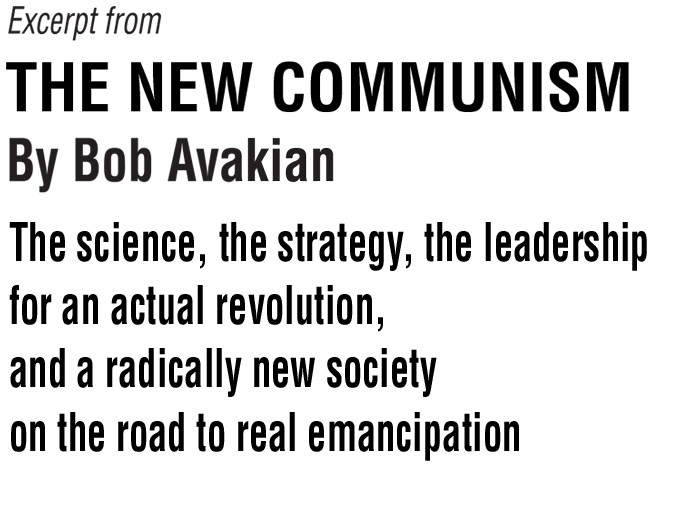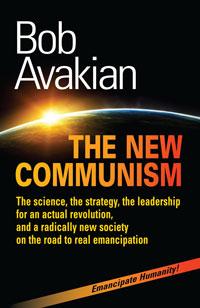
The following is an excerpt from the work by Bob Avakian, The New Communism. In addition to this and other excerpts posted on revcom.us, we will be running further excerpts from time to time on revcom.us. These excerpts should serve as encouragement and inspiration for people to get into the work as a whole, which is available as a book from Insight Press and as a PDF online at revcom.us.


This excerpt comes from the section titled "I. Method and Approach, Communism as a Science."
All this goes on while, as pointed out in the polemic against Alain Badiou32 in Demarcations #1, the system of capitalism-imperialism “hums in the background,” destroying lives and crushing spirits. And people are conditioned—by family, by friends, by society in the larger sense—that the way you should approach life is not to question why things are the way they are, and not to question whether they could be different, but just to find your place within the world as it is, and do the best for yourself and maybe a small circle of people around you (your family and your really close friends), having no sense of the larger forces at work that are shaping things. Let’s face it: that is how most people spontaneously approach things—how they are shaped and conditioned, living under this system, to approach things. The very basic question of what your life is going to be about gets shaped, once again, by the system—its basic relations and dynamics, and the culture that arises on the basis of that. It’s pursue your dreams, it’s how are you going to make your way in this world as it is. As opposed to stepping back and questioning whether the world has to be this way—and, from that perspective, what should your life be about?
Toward the end of my Memoir33 this question is spoken to: What are you going to do with your life? Are you gonna put your snout in the trough and try to scarf up as much as you can, are you just gonna try to do the cutthroat thing and beat everybody else out? Or could you give your life to making a really different, and much better, world? And people do get drawn toward that, but then once again the system has well-worn channels and ruts to funnel them into—including charities, and so on. These things may do, or may have the orientation of trying to do, some good things, and the people who get drawn to them may have good intentions; but, ultimately and fundamentally, it ends up reinforcing the world as it is. Yet, spontaneously, most people just go along with all this. As I said, people are conditioned by the society at large, and also by their immediate family and friends, that this is the only realistic way to approach the world.
I’m going to talk about this more, a little bit later—what we might call the “George Carlin point.” I don’t know if you are familiar with this routine by the comedian George Carlin, where he starts off talking about how certain kinds of parents just let their kids do all kinds of messed up things, and he goes on talking about this for a while, and then he shifts and says: “He’s not gonna say something bad about little kids, is he?” And he immediately follows this up with: “Yes, he is!” Well, to give you a preview: “He’s not gonna say that youth should rebel against their parents, is he?” “Yes, he is!”
But the basic point is this: We need to fully recognize, and act on, the importance of lifting people’s sights, and lofting their “dreams”—bringing to them an awareness and basic understanding of those larger forces at work, encouraging and enabling them to experience how important and uplifting it is to approach the world with the restless curiosity and critical thinking of the scientific method—to question, to concern oneself with and, yes, agonize over the state of the world and the conditions of the masses of humanity, searching for answers to all this, on a scientific basis, and seriously engaging whether revolution and communism is the solution.
To be clear, I’m not saying you just go to people and say, “You know, it’s very uplifting to do this,” and they respond, “Oh, I wish somebody had told me that earlier, let me get into it right now.” This is going to be a matter of a tremendous amount of struggle. But struggle that’s both down on the ground and very lofty at the same time, that’s the point. Because we do need to make all this a powerful force and “pole of attraction” for growing numbers of people. “Jolts” in society, social upheaval and mass resistance, will provide more favorable ground for doing this, and we should seize on every opening this provides, but here again we cannot tail spontaneity and hope for objective developments to do our work for us—we have to wage struggle, in a compelling way, and bring forward an inspiring world outlook and method, morality and meaning to life, embodied in the communist revolution and its goal of emancipating humanity, to wrench people out of the rut, and the pit, into which the workings of this system casts and grinds down people. Without this, masses of people will never come to see the need, or the possibility, for a radical change in society and the world, will never be won to revolution and communism.
32. Raymond Lotta, Nayi Duniya and K. J. A., “Alain Badiou’s ‘Politics of Emancipation’: A Communism Locked Within the Confines of the Bourgeois World” in Demarcations: A Journal of Communist Theory and Polemic, Issue Number 1, Summer-Fall 2009. Available at demarcations-journal.org and revcom.us. [return]
33. Bob Avakian, From Ike to Mao and Beyond: My Journey from Mainstream America to Revolutionary Communist, A Memoir by Bob Avakian (Insight Press, 2005). [return]
Contents
Publisher's Note
Introduction and Orientation
Foolish Victims of Deceit, and Self-Deceit
Part I. Method and Approach, Communism as a Science
Materialism vs. Idealism
Dialectical Materialism
Through Which Mode of Production
The Basic Contradictions and Dynamics of Capitalism
The New Synthesis of Communism
The Basis for Revolution
Epistemology and Morality, Objective Truth and Relativist Nonsense
Self and a “Consumerist” Approach to Ideas
What Is Your Life Going to Be About?—Raising People’s SightsPart II. Socialism and the Advance to Communism:
A Radically Different Way the World Could Be, A Road to Real EmancipationThe “4 Alls”
Beyond the Narrow Horizon of Bourgeois Right
Socialism as an Economic System and a Political System—And a Transition to Communism
Internationalism
Abundance, Revolution, and the Advance to Communism—A Dialectical Materialist Understanding
The Importance of the “Parachute Point”—Even Now, and Even More With An Actual Revolution
The Constitution for the New Socialist Republic in North America—
Solid Core with a Lot of Elasticity on the Basis of the Solid Core
Emancipators of HumanityPart III. The Strategic Approach to An Actual Revolution
One Overall Strategic Approach
Hastening While Awaiting
Forces For Revolution
Separation of the Communist Movement from the Labor Movement, Driving Forces for Revolution
National Liberation and Proletarian Revolution
The Strategic Importance of the Struggle for the Emancipation of Women
The United Front under the Leadership of the Proletariat
Youth, Students and the Intelligentsia
Struggling Against Petit Bourgeois Modes of Thinking, While Maintaining the Correct Strategic Orientation
The “Two Maximizings”
The “5 Stops”
The Two Mainstays
Returning to "On the Possibility of Revolution"
Internationalism—Revolutionary Defeatism
Internationalism and an International Dimension
Internationalism—Bringing Forward Another Way
Popularizing the Strategy
Fundamental OrientationPart IV. The Leadership We Need
The Decisive Role of Leadership
A Leading Core of Intellectuals—and the Contradictions Bound Up with This
Another Kind of “Pyramid”
The Cultural Revolution Within the RCP
The Need for Communists to Be Communists
A Fundamentally Antagonistic Relation—and the Crucial Implications of That
Strengthening the Party—Qualitatively as well as Quantitatively
Forms of Revolutionary Organization, and the “Ohio”
Statesmen, and Strategic Commanders
Methods of Leadership, the Science and the “Art” of Leadership
Working Back from “On the Possibility”—
Another Application of “Solid Core with a Lot of Elasticity on the Basis of the Solid Core”Appendix 1:
The New Synthesis of Communism:
Fundamental Orientation, Method and Approach,
and Core Elements—An Outline
by Bob AvakianAppendix 2:
Framework and Guidelines for Study and DiscussionNotes
Selected List of Works Cited
About the Author